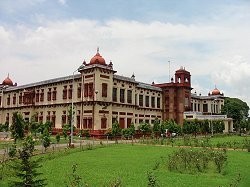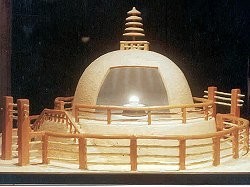Patna Museum is the state museum of the Indian state of Bihar. Built in 1917 during the British Raj to house the historical
Patna Museum
Location of Patna
in Bihar, India
Open: 10.30 am- 4.30 pm
Days: Tues- Sun
Items on display in the multipurpose museum include archaeological objects, coins, art objects, paintings, instruments, textiles, paintings, thankas, bronze images, and sculptures and terra cotta images by Hindu and Buddhist artists.[1] It has a rare collection of British-period paintings depicting day-to-day life, as well as a fine collection related to the first President of India, Dr. Rajendra Prasad.
The fossil of a tree said to be more than 200 million years old is on display, as is a casket — unearthed in 1958 by archaeologist A. S. Altekar at the Relic Stupa of Vaishali — said to contain the sacred ashes (relics) of Gautama Buddha. The world-famous Didarganj Yakshi statue, discovered on a Ganges riverbank in 1917, is the museum’s most prized collection.
Beginning November 2009, a project was started to build a replacement museum in Patna to enable the display of larger collections of up to 20,000 objects.
This excellent museum contains metal and stone sculptures dating to the Mauryan and Gupta periods, terracotta figures and archaeological finds from sites in Bihar such as Nalanda. It is a destination that is worth your luxury or cheap flights to India because of its rich history and cultural treasures. The Patna Museum also houses the world’s longest fossilized tree -16m long and 200 million years old. There is a fine collection of Chinese paintings and thangkas.
Patna Museum was established in the year 1917. The aim behind the establishment of the museum was to impart a scientific vision to understand the evolution of history, culture and
Patna museum has a large collection of sculptures of the Gandhara and the Mathura style art. These sculptures belong to the Kushana period. The
Patna Museum houses many historic items found during excavations in different parts of Bihar. Some belong to the pre-historic phase and some are from
The museum at Patna has some pre-historic objects of great interest including of Palaeoliths, microliths
The museum also displays sculptures from the Kushana period, which include the famous trio from






